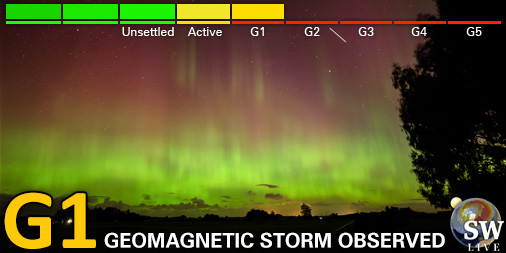Het archief bekijken van vrijdag 16 mei 2003
Activiteitenrapport
Bij elke genoemde zonnevlam in dit rapport werd een schaalfactor toegepast door het Space Weather Prediction Center (SWPC). Vanwege de SWPC-schaalfactor worden zonnevlammen 42% kleiner gerapporteerd dan voor de wetenschappelijke data. De schaalfactor werd verwijderd uit onze gearchiveerde zonnevlamdata om de werkelijke fysieke eenheden weer te geven.
Rapport van de zonne- en geofysische activiteit van 2003 May 16 2200 UTCOpgemaakt door de NOAA © SWPC en verwerkt door Poollicht.be
USAF/NOAA rapport van de zonneactiviteit en geofysische activiteit
SDF Nummer 136 gepubliceerd omstreeks 2200Z op 16 May 2003IA. Analyse van de actieve zonneregio's en zonneactiviteit van 15-2100Z tot 16-2100Z
Solar activity has been very low. No new regions were
numbered today.
IB. Voorspelling zonneactiviteit
Solar activity is expected to be very
low, with possible increase in activity over the next few days due
to returning regions emerging from the east limb.
IIA. Samenvatting geofysische activiteit 15-2100Z tot 16-2100Z
The geomagnetic field has been at unsettled to active levels. Solar
wind velocity continues to decrease as the previous coronal hole
rotates across the west limb. The greater than 2 MeV electron flux
at geosynchronous orbit reached high levels today.
IIB. Voorspelling geofysische activiteit
The geomagnetic field is
expected to be at unsettled levels for the next two days, with
active conditions possible on day three of the period due to a
coronal hole passing into geoeffective position.
III. Kans zonnevlammen van 17 May tot 19 May
| Klasse M | 05% | 10% | 10% |
| Klasse X | 01% | 01% | 01% |
| Proton | 01% | 01% | 01% |
| PCAF | green | ||
IV. Penticton 10.7 cm Flux
Geobserveerd 16 May 103 Voorspeld 17 May-19 May 110/115/120 90 dagen gemiddelde 16 May 124
V. Geomagnetische A index
Geobserveerd Afr/Ap 15 May 019/023 Geraamd Afr/Ap 16 May 010/012 Voorspeld Afr/Ap 17 May-19 May 010/012-010/012-015/020
VI. Kansen op geomagnetische activiteit van 17 May tot 19 May
| A. Gemiddelde breedtegraad | |||
|---|---|---|---|
| Actief | 20% | 20% | 30% |
| Kleine storm | 10% | 10% | 15% |
| Zware-ernstige stormcondities | 01% | 01% | 05% |
| B. Hoge breedtegraad | |||
|---|---|---|---|
| Actief | 35% | 35% | 35% |
| Kleine storm | 15% | 15% | 20% |
| Zware-ernstige stormcondities | 05% | 05% | 05% |
Alle tijden in UTC
<< Keer terug naar de dagelijkse overview pagina
Op basis van de huidige parameters is er nu geen kans op poollicht in België en Nederland
Op basis van de huidige parameters is er in de nabije toekomst een beperkte kans op poollicht op de volgende locaties van de hoge breedtegraad
Gillam, MB, Saskatoon, SKLaatste nieuws
Laatste forumberichten
Suggesties? 8Noorderlicht kans 6-1-2025 2Poollicht 1 januari 2025 2Naar Noorwegen in Maart? 3Noorderlicht kans 10/11-10-2024 56
Meer forumberichtenSteun Poollicht.be!
Om ook bereikbaar te blijven bij grote poollichtkansen hebben we een zware server nodig die alle bezoekers aankan. Doneer en steun dit project zodat we online blijven en je geen enkele poollichtkans mist!

Laatste alerts
zondag 4 mei 2025
15:09 UTC - Hemisferisch vermogen
Het OVATION-model voorspelt dat het hemisferisch vermogen 50GW zal bereiken om 15:48 UTC
08:00 UTC - Geomagnetische activiteit
G1 - Kleine geomagnetische storm (Kp5) Drempel bereikt: 07:52 UTC
zaterdag 3 mei 2025
10:45 UTC - Geomagnetische activiteit
G1 - Kleine geomagnetische storm (Kp5) Drempel bereikt: 10:30 UTC
08:57 UTC - Hemisferisch vermogen
Het OVATION-model voorspelt dat het hemisferisch vermogen 76GW zal bereiken om 09:32 UTC
Ruimteweer feitjes
| Laatste X-klasse uitbarsting | 28/03/2025 | X1.1 |
| Laatste M-klasse uitbarsting | 30/04/2025 | M2.03 |
| Laatste geomagnetische storm | 03/05/2025 | Kp5 (G1) |
| Zonnevlekkenloze dagen | |
|---|---|
| Laatste zonnevlekkenloze dag | 08/06/2022 |
| Maandelijks gemiddeld zonnevlekkengetal | |
|---|---|
| april 2025 | 140.6 +6.4 |
| mei 2025 | 66.5 -74.1 |
| Afgelopen 30 dagen | 111.6 -20.3 |




